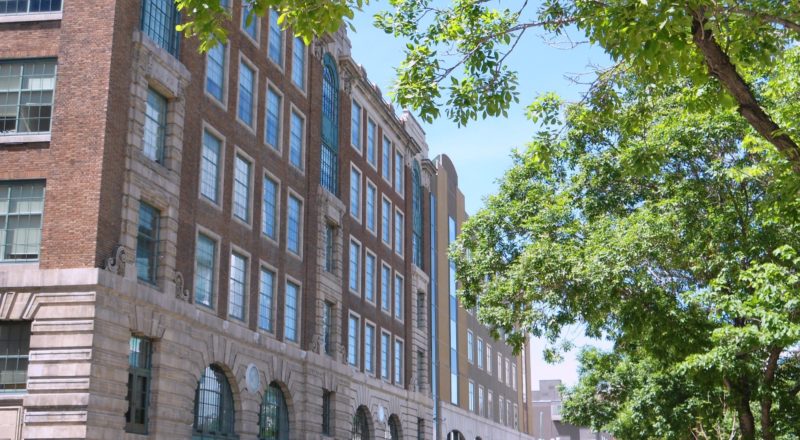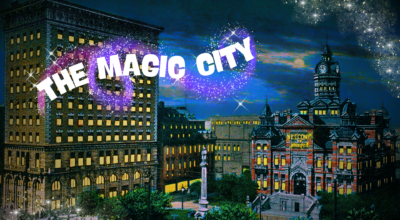
/ Blog
January 8, 2020
The Old Lady of Carlton Street: The Winnipeg Free Press Building
The Manitoba Health Offices building at 300 Carlton Street does not try to hide what it once was. Along the roof, in boxy letters, are the words “FREE PRESS”.
It is a not-so-subtle reminder of the building’s publishing past. For 79 years, 300 Carlton Street was the home of the Winnipeg Free Press, Manitoba’s oldest newspaper. Today, the building is a quieter office space tucked away behind the new development of Portage Place Mall.
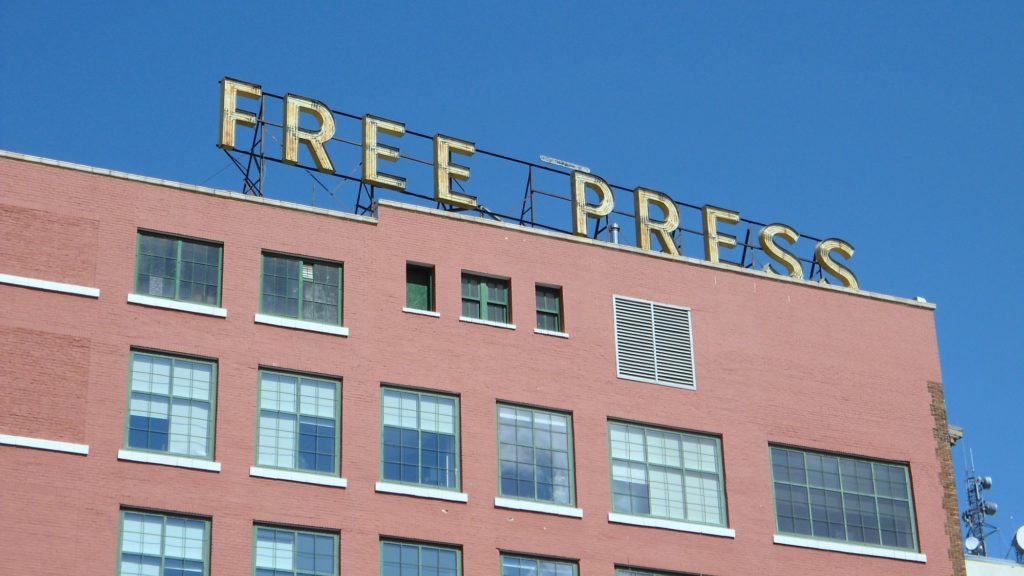
The back of the Free Press Building at 300 Carlton Street in June 2012.
Source: Interlaker (CC0, via Wikimedia Commons)
Decades ago, though, 300 Carlton would have been buzzing with excitement. The machinery of the printing press would hum, staff pounding away furiously at their typewriters, surrounded by the frenetic energy of a newsroom in one of Canada’s fastest growing cities. When the Winnipeg Free Press moved into their Carlton Street building in 1905, there was hardly a shortage of news to report; hopes were high in Winnipeg and bigger and better developments were happening on the daily. Carlton Street may have been the sixth home of the Winnipeg Free Press, but was the very first that had been purpose built for their needs.
The earlier Free Press Offices were not quite as glamorous, or roomy. When the Winnipeg Free Press (then the Manitoba Free Press) was founded in 1872, it’s owners William Luxton and John Dafoe rented out a small wooden shack at 555 Main Street. That same year an election riot led to the ransacking of three newspaper’s buildings: the Manitoban, Le Metis, and the Gazette. The Manitoba Free Press remained unscathed, and even allowed The Manitoban to publish a short bulletin on their presses.
In 1874, they moved to an office on Main Street near St. Mary Avenue and then moved again in 1882 to the corner of McDermot Avenue and Main Street. They remained there until 1900, when continued growth prompted the Free Press to relocate a block down the road into the Lyon Block at 221 McDermot Avenue. Neighbouring the Winnipeg Free Press on McDermot were its two staunch rivals, the Winnipeg Tribune and Winnipeg Telegram.
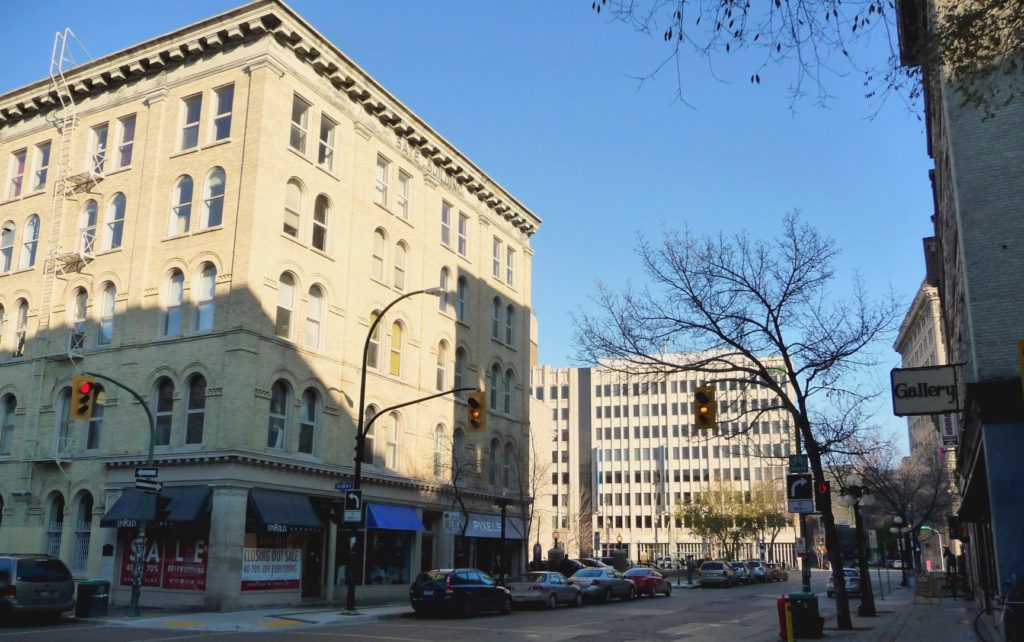
Lyon Block at 221 McDermot Avenue (left) in November 2011. The building’s name was changed to the Bate Building in 1942.
Source: Herb Neufeld (CC BY 2.0, via Wikimedia Commons)
For the next five years every major Winnipeg newspaper operated out of the same intersection at Albert Street and McDermot, earning the area the nickname of “Newspaper Row”. After those five years, the Winnipeg Free Press would vacate the Lyon Block and head to a four-storey office on the corner of Portage Avenue and Garry Street. At the time of the Winnipeg Free Press’s move, this was the largest building in Canada to be used exclusively as a newspaper headquarters.
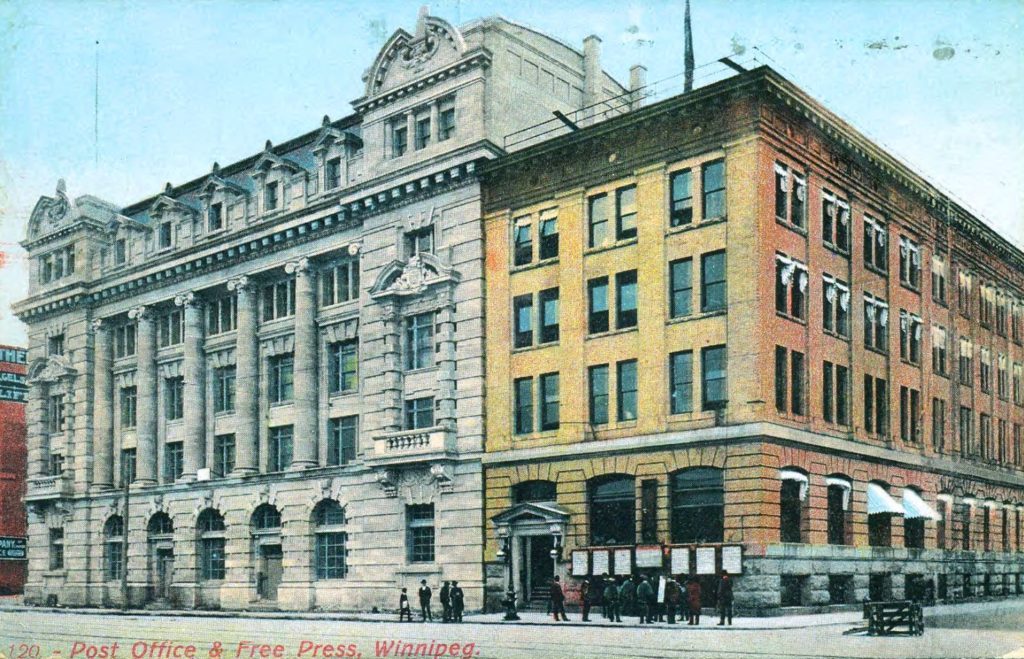
The 1904 Free Press Building (right) at southeast corner of Portage Avenue and Garry Street in 1908. The Paris Building now stands at this location.
Source: The Rob McInnes Postcard Collection (Winnipeg Public Library)
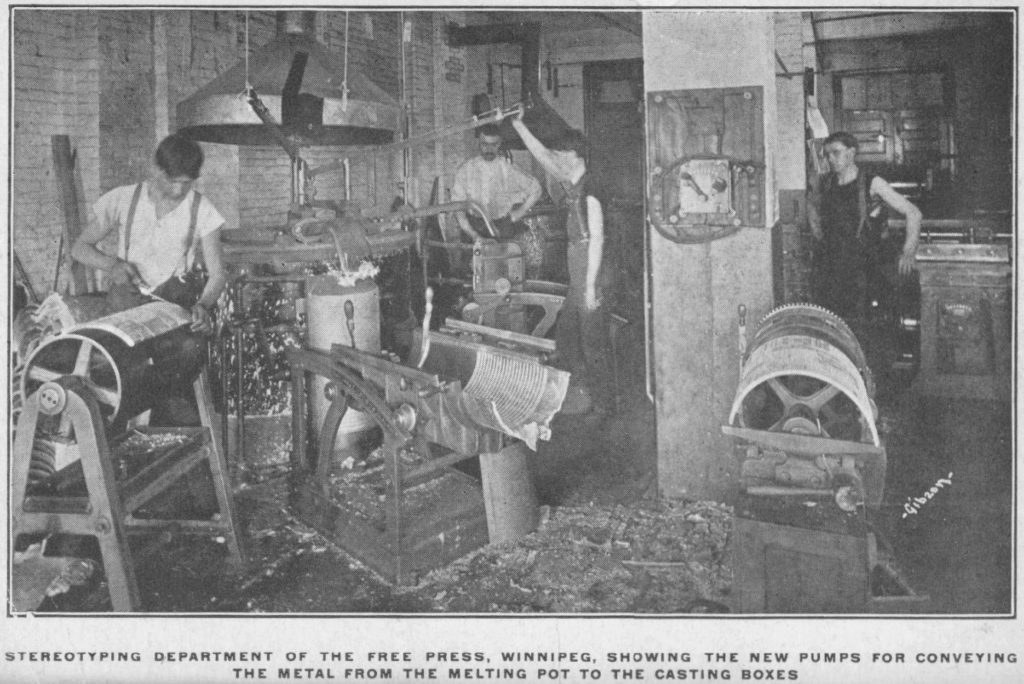
Inside the Free Press Building at southeast corner of Portage Avenue and Garry Street some time between 1904 and 1914.
Source: The Rob McInnes Postcard Collection (Winnipeg Public Library)
The Winnipeg Free Press’s circulation did not slow down, and within five years another move was necessary. This time, though, the Winnipeg Free Press hired architects Woodman and Carey to design a new purpose-built space.
One of the principal architects on the project, John Woodman, was a pioneer of pre-World War 1 steel frame architecture in Winnipeg and designed an office building with a steel skeleton frame and concrete supports.
Due to the highly public nature of the Winnipeg Free Press both the facade and the interior had to be stately and respectable. Designed in the subdued reduced Classical style, the Free Press Building’s facade is covered in a regular pattern of various rectangular and multi-paned windows. Some windows are accentuated with tops, others stone-framed, and others lined with delicate stonework. Two storey tall openings on the main floor are framed by heavy stone, capped with an entablature lined with stone bison heads.
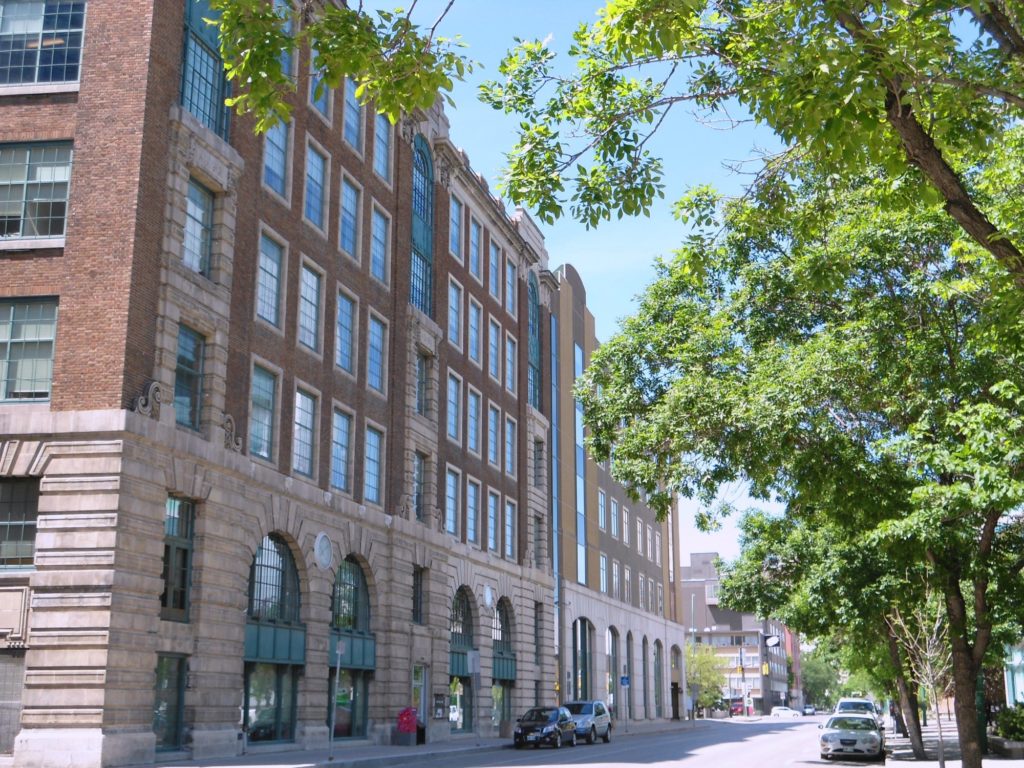
The Free Press Building at 300 Carlton Street in June 2012.
Source: Interlaker (CC0, via Wikimedia Commons)
Inside, the building had to be a one-stop shop for a company’s newspaper printing needs. Factory space, shipping and receiving areas, and office spaces were all needed – and some of this required special construction. The Press Room, where heavy printing machinery was used in the basement, required its own foundation separate from the rest of the structure.
Upstairs, the front lobby was spacious and welcoming, and held a receiving area for classified ads. Reporters worked out of the fourth floor, above printer’s workspaces which took up the bulk of the six-storey building.
The Winnipeg Free Press officially moved into their new location on the weekend of April 5th, 1913 where they would remain until the 1990s.
Across the building’s 79 years in operation it drew crowds continually. In the 1910-20s, those without access to a radio could gather outside to hear updates on whatever sporting match happened to be taking place that day – be it boxing, baseball, or hockey.
One particular entertainer drew a much larger crowd when, on February 20th 1923, he suspended himself upside-down from 300 Carlton Street. Harry Houdini was in town performing a week-long series of shows that would “startle and amaze” at the Winnipeg Orpheum Theater. In an unusual promotional move, Houdini also opted to put on a more public display of his skills. Somewhere around 5,000 on-lookers gathered as Houdini, suspended 30 feet above the ground, attempted to break out of a straight-jacket – which he did, in only two minutes!
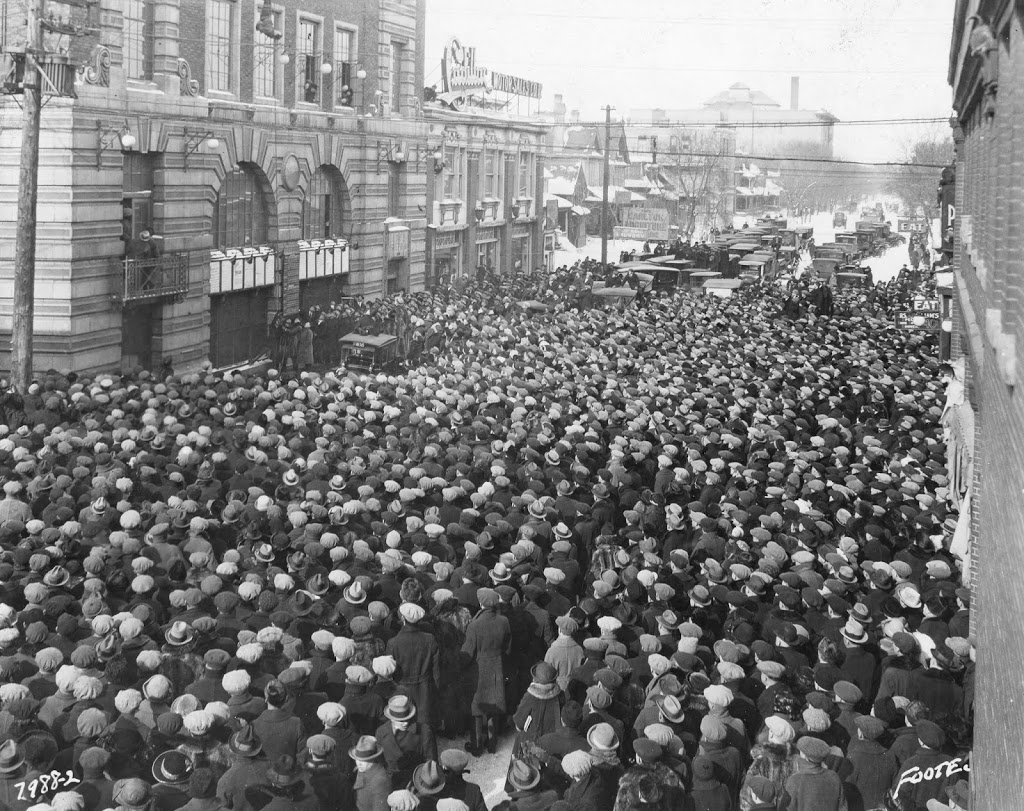
It’s a bit of a Where’s Waldo but if you look up along the top left of the image, you can spot Houdini dangling upside down with the Free Press Building in the background.
Source: L.B. Foote, Archives of Manitoba
Inside the building, things were just as exciting. Long-time reporter Vince Leah recalled a time where bottles of liquor were stashed behind toilets and in darkrooms, and could tell stories of typwriters being tossed from windows and of rowdy groups of reporters. Pioneering journalists like Ella Cora Hind, the first female reporter in Western Canada, also worked out of the fourth floor newsroom – and a plaque in her honour remains on the side of 300 Carlton to this day.
As newer printing technologies came and went, the Free Press building was updated and renovated so few of those original working spaces remain. A two-storey garage original to the building was renovated in 1926 to add four storeys and create additional publishing space.
This continual change allowed the Free Press to remain in the building for decades and and both the Winnipeg Free Press and 300 Carlton Street earned the nickname “The Old Lady of Carlton Street”.
The nickname stuck.
When the Winnipeg Free Press finally left 300 Carlton Street to their current location at 1355 Mountain Avenue, a full-page memorial was printed for the Old Lady, alongside a mock obituary.
The last of Canada’s great Front Page-era newsrooms put its Final Edition to bed at midnight and then – with friends and family by its side – The Old Lady of Carlton Street passed away peacefully in her sleep.She was 79.A family spokesman said the building succumbed to old age. But at the end, the Old Lady’s heart – its pressroom – was still pumping, even if her big brick body was too weak to withstand the onslaught of technology.Staffers present and past gathered in the newsroom early this morning to toast The Final Deadline. It was a tribute to a newsroom whose unkempt, sodden, carefree character symbolized a time – and a newspaper lifestyle – long gone.The building is survived by a new Free Press plant that begins operation Tuesday from the Inkster Industrial Park.
-Gordon Sinclair Jr, “Goodbye Sweetheart” Winnipeg Free Press August 4th 1991 (3)
Fondness for the building did not immediately bring forward any new tenants. Still, hope for the building remained and unlike other vacant buildings in the 1990s demolition was not seriously considered for the old Free Press headquarters. As is always the case, ideas came and went until 1997, when Air Canada received a tax credit to renovate the building – though this didn’t go anywhere. The building was still vacant when it was designated by the City of Winnipeg on May 4th, 1998.
Today, the Government of Manitoba occupies some of the space with offices for Manitoba Health, Seniors and Active Living. It may not have the thrill of the old newsrooms, or the whirr of machinery any longer, but part of Manitoba’s history still lives on – marked by a distinctive boxy sign.
THANK YOU TO THE SPONSOR OF THIS BLOG POST:

Written by Heritage Winnipeg.
SOURCES:
Favourite Foote Photos: Brett Lougheed | Brett Lougheed - Lost Foote Photos - April 3, 2012
Goodbye Sweetheart | Gordon Sinclair Jr. - The Winnipeg Free Press - August 4, 1991, page 3
Great escapes | Doug Speirs - Winnipeg Free Press - September 21, 2013
Heritage Winnipeg files





